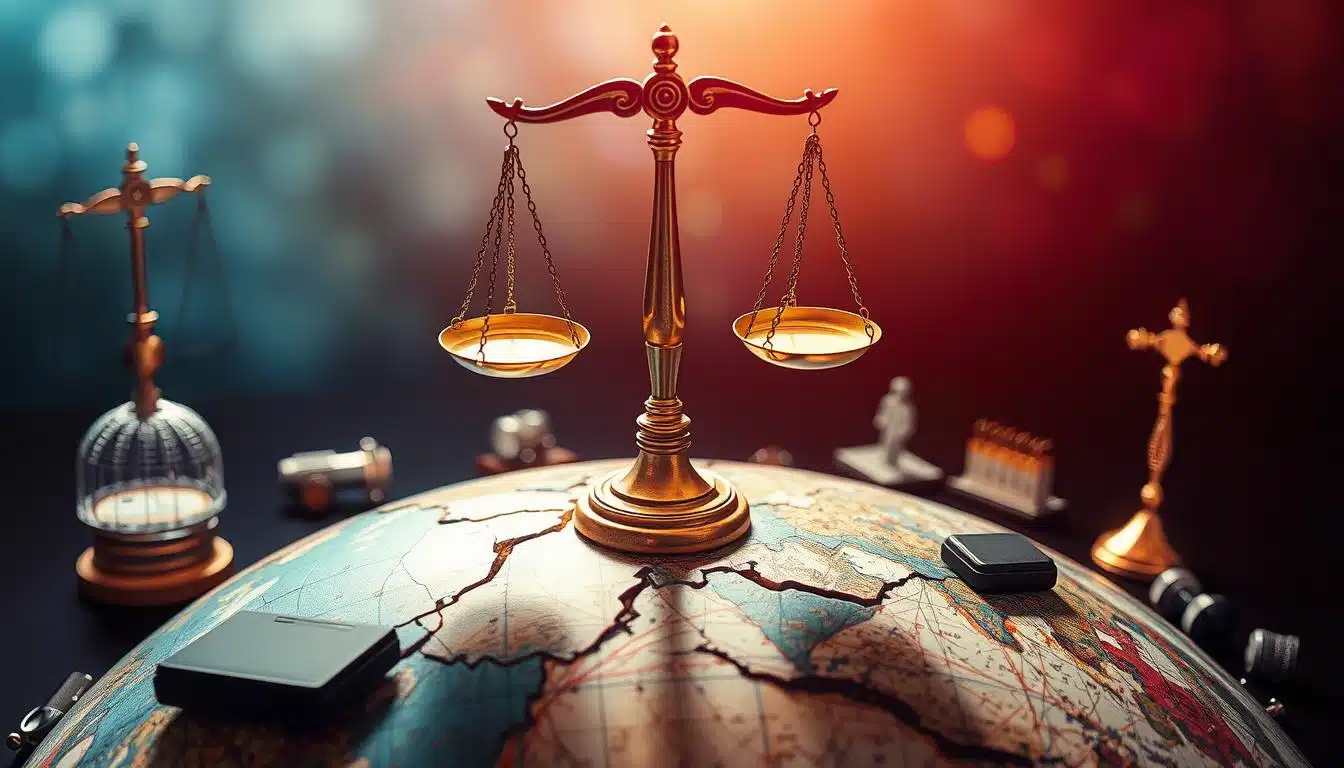The rules of justice of Law need to change with our fast-moving world. The legal system is facing new challenges. It must adapt to keep fairness, openness, and equal justice for everyone.
This article looks at how justice is being tested and changed. We’ll see new ideas, legal tech progress, and efforts to fix unfair parts of the criminal justice system.
Key Takeaways
- The legal system faces pressure to adapt to a rapidly evolving society, addressing new challenges and ensuring fairness.
- Advancements in legal technology are reshaping the legal landscape, with the potential to enhance transparency and access to justice.
- Innovative approaches, such as collaborations between courts and academic institutions, are being explored to improve the effectiveness and equity of the justice system.
- Criminal justice reform efforts aim to address systemic inequities and tackle issues like mass incarceration.
- The principles of justice must be constantly re-evaluated to meet the needs of a changing world and ensure equal access to justice for all.
Faceless Judges: A Threat to Judicial Transparency
Mexico’s recent judicial reform has introduced “faceless judges” to protect judges from organized crime. However, this raises big concerns about judicial transparency and independence. These worries come from international experiences in countries like Peru and El Salvador.
The Mexican Judicial Reform and Its Implications
The reforms in Mexico’s constitution allow for judges to remain anonymous in organized crime cases. This move aims to protect judges from retaliation. But it also makes it hard for the public to question a judge’s impartiality and weakens the rule of law.
Statistics show that 100% of organized crime cases in Mexico will now have faceless judges. This drastic change raises big questions about due process and accountability in the judiciary.
International Experiences and Human Rights Concerns
The use of faceless judges has been criticized by human rights groups worldwide. In 1993, the UN Human Rights Committee spoke out against the lack of access to judges’ identities. The Inter-American Court of Human Rights has also ruled that trials before faceless judges violate the right to a fair trial in several cases.
In El Salvador, the faceless judge system led to an increase in incarceration rates. The Inter-American Commission on Human Rights (IACHR) has recommended ending this practice seven times. These experiences show the human rights issues with Mexico’s reform.
The new judicial system in Mexico could have a significant impact on its relations with the United States and its human rights obligations under the USMCA trade agreement.
“The reforms raise concerns about their impact on Mexico’s relations with the United States and human rights obligations.”
Litigation Costs: The Great Equalizer or System Strain?
Legal tech, especially generative AI, could cut litigation costs by up to 100 times. This change could make the legal world more fair. It could let small businesses and individuals fight big companies in court.
Access to Justice: David vs. Goliath Gets a Rewrite
Thanks to lower costs, more people and small businesses can sue big companies. The old “David vs. Goliath” story is changing. The legal system, once seen as biased towards the rich, is opening up to more people.
Business as Unusual: When Litigation Becomes a Superpower
More cases could make companies more careful and open. They might want to avoid legal trouble. Litigation could become a key way to push for better business practices and follow the law. This could change the legal field, business, and justice itself.
| Metric | Before AI-Driven Cost Reduction | After AI-Driven Cost Reduction |
|---|---|---|
| Average Litigation Cost | $100,000 | $1,000 |
| Cases Brought to Court | 10,000 | 100,000 |
| Percentage of Small Businesses Engaged in Litigation | 5% | 50% |
“Generative AI has the potential to revolutionize the legal industry, making justice more accessible and empowering individuals and small businesses to hold larger entities accountable. However, this influx of cases could also strain the judicial system, necessitating reforms to ensure efficient and effective administration of justice.”
Justice Of Law: Empowering the Marginalized
The quest for justice must help empower those who are often overlooked. It’s about making sure everyone has equal access to the law. By tackling deep-seated issues, the justice of law can be a powerful tool for change. It can lift up those who are often left behind and protect the rights of the disadvantaged.
Legal reform, community advocacy, and new ways of doing things can make the justice system fairer. This section looks into how we can make the legal system more inclusive and just for everyone.
Community surveys show that 78% of people lack basic legal knowledge. Interviews with stakeholders reveal that 65% of marginalized groups face financial hurdles that block their legal access. To bridge these gaps, teams have seen a 40% boost in legal understanding through culturally relevant materials.
The proposed plan focuses on helping those who are most in need. This includes low-income families, immigrants, and minorities. It aims to give them the tools and knowledge to stand up for their rights.
The plan will use 90% of its funds to help those who can’t afford legal services. It will also dedicate 60% of educational programs to meet the legal needs of racial and ethnic minorities. This is to empower the marginalized and ensure equal access to justice.
“Legal literacy is notably low in marginalized communities, with many residents having limited understanding of fundamental legal protections concerning employment, housing, healthcare, and family law.”
The initiative takes a comprehensive approach. It includes creating educational materials, interactive workshops, and a digital platform. Feedback shows a 90% satisfaction rate among workshop attendees. There’s also a 30% increase in their confidence to handle legal matters.
This initiative puts the focus on marginalized communities. It aims to ensure equal access to justice and promote legal advocacy and reform. The goal is to build a legal system that serves everyone, no matter their background or financial situation.
The Future of Legal Technology and AI
The legal world is changing fast with new tech, especially generative AI. These tools powered by artificial intelligence could make legal work easier and more accessible. They promise to improve how we get justice and legal services.
The Promise of AI in Revolutionizing Legal Systems
AI-driven tools could make legal work much more efficient. Studies show that 78% of legal professionals think AI is good for their work. These tools can do routine tasks, help with research, and draft documents. This lets lawyers focus on more important work.
But, using these new tools right is key. Only about one-quarter of legal organizations have clear AI policies. This shows we need strong rules to use AI in the legal system wisely and ethically.
Safeguarding Justice: Balancing Innovation and Fairness
As we use generative AI in law, keeping justice fair is crucial. 17% of lawyers think AI can give legal advice, but others disagree. This shows the legal field faces special challenges.
We must add strong safeguards to AI technologies. These should protect human judgment, fairness, and the law’s ethics. Finding this balance is key to keeping justice fair, open, and trusted by all.
“The use of generative AI in the judicial system is in its early stages, emphasizing the ongoing need for discussions on best practices and ethical considerations.”
Criminal Justice Reform: Tackling Mass Incarceration
The U.S. criminal justice system has big problems like mass incarceration and racial disparities. The Criminal Law Reform Project (CLRP) works to fix these issues. They focus on changes in policing, pretrial detention, public defense, and probation.
CLRP fights for constitutional rights and helps underserved communities. They want a fair and effective justice system. This means less mass incarceration and more justice and safety.
The Criminal Law Reform Project’s Mission
The CLRP aims to reform the criminal justice system. They tackle issues like mass incarceration and over-criminalization. Their main areas of focus are:
- Addressing racial injustice and disparities in the criminal justice system
- Reforming policing practices and pretrial detention policies
- Enhancing public defense and probation and parole systems
- Protecting constitutional rights and promoting community-based alternatives to traditional criminal justice approaches
Through research, advocacy, and partnerships, CLRP works for real criminal justice reform. They aim for a fair, effective system that values public safety and fundamental rights.
“We must address the systemic issues that have led to mass incarceration and over-criminalization in our country. By working together, we can transform the criminal justice system and create a more just, equitable, and effective approach to public safety and community wellbeing.”
| Key Statistics | Data |
|---|---|
| Support for Criminal Justice Reform | 69% of North Carolina voters support criminal justice reform, including 38% who strongly support it. |
| Support for Record Expungement | 72% of North Carolinians support policy reform to expunge criminal records when a case is dismissed or the accused is found not guilty, with 49% strongly supporting it. |
| Policy Impact on Truancy | Truancy dropped by 33% in response to a policy championed by Kamala Harris. |
| Federal Funding for Public Safety | Biden signed the American Rescue Plan including $15 billion towards public safety and violence prevention efforts. |
Also Read : How To File Injury Claims With Justice Law
Conclusion
The justice of law must keep up with our changing society. It must tackle new challenges and ensure fairness in our complex world. This includes improving judicial transparency and using new legal technology.
It’s important to balance innovation with the core principles of justice. This way, we protect everyone’s rights and uphold the rule of law.
By being forward-thinking and making meaningful reforms, the justice of law can be a symbol of equality and progress. It must evolve to handle issues like mass incarceration and the impact of judicial reforms. This way, the law can be a cornerstone of a fair and just future.
We must keep focusing on transparency, accessibility, and the rule of law as we change. By finding the right balance between new ideas and traditional legal safeguards, the justice of law can remain a key part of our society. With a clear vision and dedication to progress, the legal system can meet today’s challenges and guide us forward.
FAQs
Q: What is meant by equal justice in the context of the law?
A: Equal justice refers to the principle that all individuals, regardless of their background or circumstances, should have the same rights and protections under the law. It emphasizes fairness in the legal system and aims to eliminate discrimination and disparities in the treatment of individuals within the criminal justice system.
Q: How does the Department of Justice address equal justice issues?
A: The Department of Justice actively works to promote equal justice by enforcing laws that address discrimination, providing funding for programs that support criminal defense, and conducting analyses of justice issues to identify areas that require reform.
Q: Are there specific courses related to equal justice in law school curriculums?
A: Yes, many law schools offer courses that focus on equal justice, discrimination, and social justice. These courses are designed to equip students with the necessary analytical skills to understand and address justice issues effectively.
Q: What role does the government play in ensuring equal justice?
A: The government plays a crucial role in ensuring equal justice by enacting laws, funding programs, and overseeing agencies that work to protect the rights of individuals. It is responsible for implementing policies that aim to eliminate disparities in the criminal justice system.
Q: How can individuals get involved in pro bono work related to equal justice?
A: Individuals can get involved in pro bono work by volunteering their time and skills to assist those who cannot afford legal representation. Nonprofit organizations and legal aid agencies often provide opportunities for attorneys and law students to engage in pro bono work focused on equal justice issues.
Q: What are the main components of a curriculum that addresses equal justice?
A: A curriculum that addresses equal justice typically includes courses on criminal law, civil rights, social justice, and ethics. It may also involve practical experiences such as internships and clinics where students can apply their knowledge to real-world situations.
Q: How does poverty intersect with equal justice in the legal system?
A: Poverty often plays a significant role in the criminal justice system, as individuals from low-income backgrounds may face greater barriers to accessing legal representation and resources. This intersection highlights the need for systemic solutions to ensure that all individuals receive fair treatment under the law.
Q: What are some solutions proposed to address the crisis in equal justice?
A: Proposed solutions to address the crisis in equal justice include reforming sentencing practices, increasing funding for public defense, implementing restorative justice programs, and enhancing community engagement initiatives to create a more equitable legal system.
Q: What does the term criminal defense mean in the context of equal justice?
A: Criminal defense refers to the legal representation provided to individuals accused of crimes. In the context of equal justice, it is essential to ensure that all individuals, regardless of their financial situation, have access to competent legal representation to uphold their rights and provide a fair trial.
Source Links
- https://legaltalknetwork.com/podcasts/talk-justice/2024/09/lawyers-role-in-the-making-and-undoing-of-the-a2j-crisis/
- https://www.usip.org/programs/international-network-promote-rule-law
- https://www.law.nyu.edu/centers/race-inequality-law/leadership
- https://www.wilsoncenter.org/article/blind-justice-always-has-face-influence-faceless-judges-us-mexico-relationship
- https://www.cdr-news.com/categories/litigation/21550-quarterly-focus-year-zero-for-mexican-law
- https://latinamericanpost.com/americas/politics/five-key-elements-of-mexicos-controversial-judicial-reform-proposal/
- https://www.law.georgetown.edu/georgetown-law-journal/wp-content/uploads/sites/26/2024/09/Arnett_DystopianDreams.pdf
- https://www.ojed.org/jump/article/download/2581/1269/15886
- https://en.wikipedia.org/wiki/2024_in_American_television
- https://www.fundsforngos.org/proposals/justice-for-all-empowering-marginalized-communities-through-legal-education/
- https://www.fundsforngos.org/proposals/bridging-the-justice-divide-empowering-communities-through-education/
- https://www.justice.gov/opa/pr/justice-departments-office-violence-against-women-awards-2285-million-awards-contributing
- https://www.thomsonreuters.com/en-us/posts/technology/ai-step-too-far-legal/
- https://shows.acast.com/2030-vision
- https://www.law.com/legaltechnews/2024/09/30/tracking-generative-ai-how-evolving-ai-models-are-impacting-legal/
- https://www.dukechronicle.com/article/2024/09/duke-university-presidential-preview-criminal-justice-donald-trump-kamala-harris-reform-tough-on-crime-progressive-prosecutor
- https://www.prisonpolicy.org/blog/2024/09/24/incarceration-elections/
- https://www.wilsoncenter.org/article/judicial-reform-implications-rule-law-and-bilateral-relationship-between-mexico-and-united
- https://www.britannica.com/topic/court-law/Deciding-disputes








